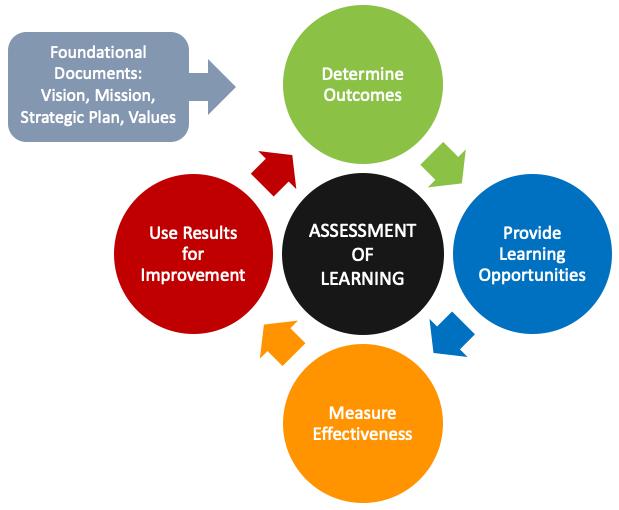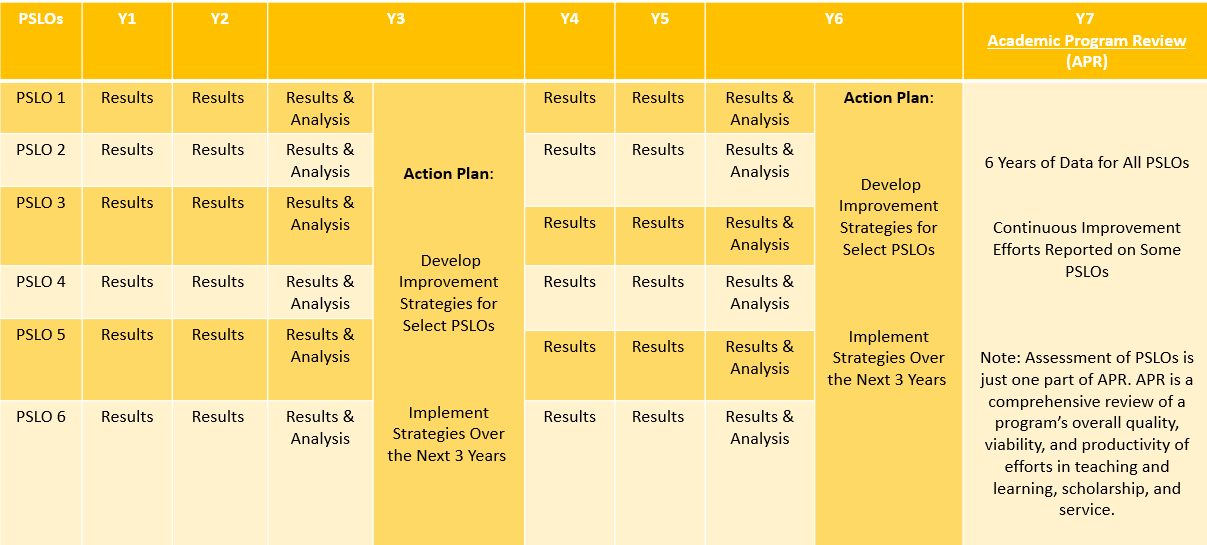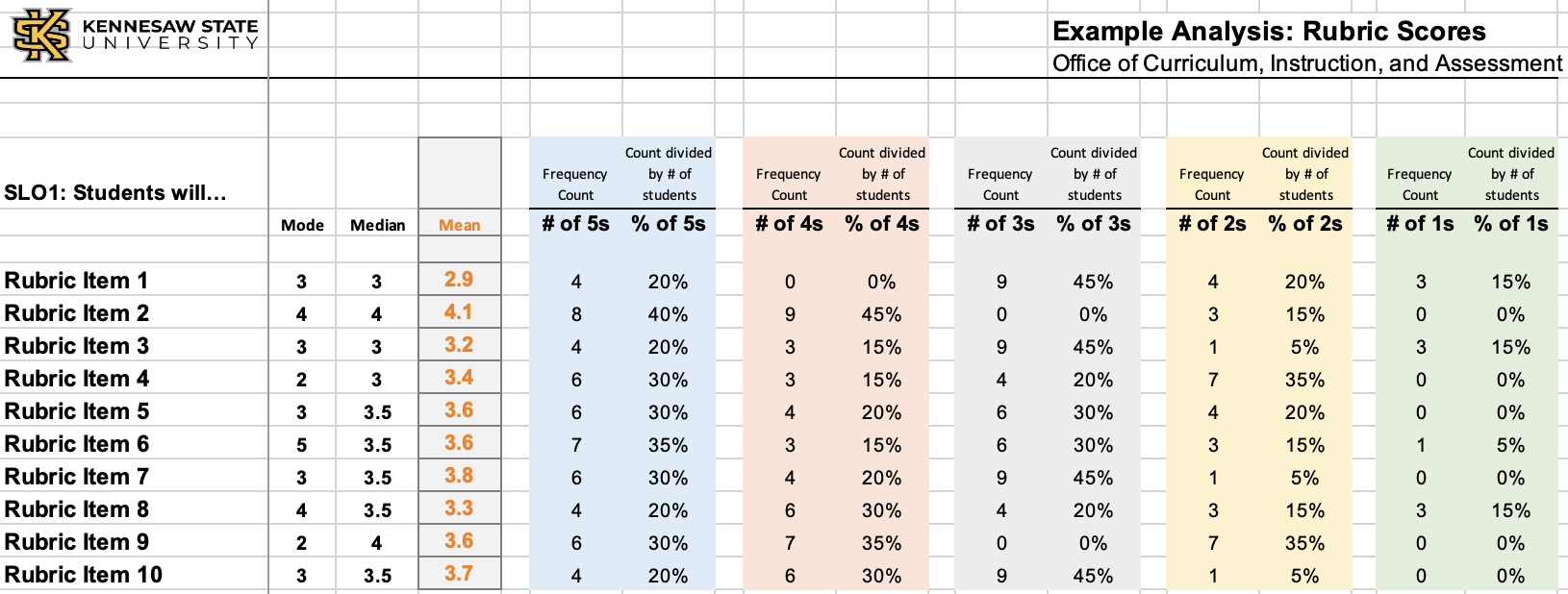Assessment of Learning

-
Assessment Plan
Each academic program must develop and maintain an active Assessment Plan, which documents how the program measures and assesses student achievement of their program student learning outcomes (PSLOs).
- All non-accredited programs should use our updated Assessment Plan Template to develop an assessment plan for assessing all PSLOs. The PSLOs included in the assessment plan should be the same PSLOs that are published in the catalog. At least one direct measure per outcome is required (i.e., rubric items, exam items, internship evaluation items, etc.). Additional measures (direct and/or indirect) are recommended.
- To support student success efforts, the Assessment Plan template also instructs programs to identify one student success outcome they are focusing on for continuous improvement. Depending on program needs, programs may focus on recruitment, retention, time-to-completion, or graduation rates. In addition to an existing institutional measure of the outcome, programs should include one additional measure that provides insight into issues related their selected student success outcome and efforts to improve that outcome.
- Accredited programs may use their assessment plan documentation included in their most recent self-study, as long as the assessment plan documentation includes valid and reliable measures for all PSLOs and an assessment schedule for assessing all PSLOs.
NOTE: All rubrics, test items, and other measures must be included either in the Measures section or in the Appendix of the Assessment Plan. Please include all items in one document (do not upload multiple documents). The only exception is for the curriculum map - this may be submitted as a separate file.
Review this checklist to ensure all criteria are met for Assessment Plan approval.
For new or modified programs submitting a Curriculog proposal, please follow the process described here.
Changes to existing Assessment Plans: If your program is modifying the outcomes and/or measures in an approved assessment plan, please use the updated Assessment Plan template to update your assessment plan. When you have a draft completed, please email it to assessment@kennesaw.edu for review and approval. Changes to an assessment plan should not disrupt the assessment process. Programs should continue to collect data as specified in your original assessment plan. Once your updated assessment plan is approved, programs should start collecting data as specified in the new plan during the next year.
-
Assessment of Learning Results - Instructions & Templates
If the AoL and APR schedule indicates that you have AoL Results due this year, then please use the Instructions and Templates for AoL Results to create your results tables/graphs.
What results should I report?
- For results due in March 2025, report the results for the PSLOs you collected data on during the previous academic year (2023-2024) or calendar year (2024).
- For results due in March 2026, programs will need to report the results for all PSLOs. Data collection on all PSLOs should start in spring 2025 so that results for all PSLOs can be reported in March 2026.
How should I format my results?
As indicated in the instructions linked above, you should use tables and/or graphs to report your results. The table/graph must include titles and other labels that clearly identify:
- The outcome
- The measure (identify the assessment tool)
- Course and exam/quiz/assignment name (if relevant)
- The name of the statistic/metric (i.e., % correct, mean score, etc.)
- Year(s) and semester(s) data was collected
- Sample size
- Description of the sample (if relevant): number of sections included out of total sections offered, course name/number course modality, etc.
- The findings for each measure for each outcome
What if I have results due but do not have any results to report?
For your results tables, please set up your tables and enter “ND” (no data) where you would typically enter your data. Under the table, include a note for “ND” and explain why there is no data to report.
-
Assessment of Learning Report - Instructions & Templates
If the AoL and APR Reporting Schedule indicates that you have an assessment report due this year (3rd year or 4th year reflection/report), then please use the 2024-2025 Assessment of Learning and Student Success Report Template to write your report.
If your program has a specialized accreditation and the self-study report includes multiple years of assessment results for all PSLOs (using reliable and valid measures) as well as strategies for improving student learning, then the reporting schedule may indicate that your program is expected to submit the most recent self-study and/or any mid-cycle reports in lieu of using the report template above.
The assessment report and/or specialized accreditation self-study serve as evidence of assessment and continuous improvement for KSU's SACSCOC accreditation (Standard 8.2).
What needs to be included in an AoL Report?
- List of all PSLOs and a curriculum map demonstrating where each PSLO is addressed and assessed.
- Description of the methods and measures used to assess your PSLOs.
- Results from the past 3-4 years with a discussion/interpretation of the trends over time.
- A discussion of specific strategies for improvement implemented over the past 3-4 years and the strategies for improvement the program plans to implement in the future.
APPENDIX: All rubrics, test items, and other measures must be included either in the Measures section or in the Appendix of the report.
Please do not upload multiple documents. Only one document will be accepted.
Please clearly label all items in the Appendix (i.e., “SLO1 – Measure 1”). Screenshots work best; copy and paste the image into the Word document.
This website explains how to take a screenshot:
Mac: https://www.take-a-screenshot.org/mac.html
PC: https://www.take-a-screenshot.org/windows.htmlEXAMPLE REPORTS: Below you will find an example of a report (from a fictitious program).
- Sample Assessment of Learning Report - Undergraduate Program
- For programs who are assessing more than the minimum of 2 PSLOs, please see our report example for assessing 5 PSLOs in the same report. The format of the report is adjusted for the number of PSLOs assessed:
How do I submit the results, report, or self-study documentation?
The report or self-study is submitted to our Assessment Office using a simple report submission form from SmartSheet that will be emailed to program coordinators in August.
When are the results, report, or self-study documenation due?
All assessment reporting (results, 3rd year report, or self-study documentation) is due on March 17.
-
Report Feedback Form
The Office of Assessment provides written feedback on all Assessment of Learning (AoL) reports (not self-studies). Below you will find the rubric and feedback form. Please review the feedback form before submitting the report to ensure all of the criteria have been met. In some cases, the report may need to be resubmitted if required information is missing or insufficient.
2023-2024 AoL Report Rubric and Feedback Form
- You may download and print a copy of the rubric and feedback form using the link above.
- You may perform a self-review of your own program's report or a peer review of another program's report using the rubric and feedback form. This self or peer review process is optional. It is for programs, departments, or colleges that wish to utilize a self or peer review process to improve the quality of their report(s) prior to submission to the Assessment Office.
- Once your report is approved by the Assessment Office, it will go through our university-level peer review process using the rubric and feedback form. The Assessment Office will also use the rubric and feedback to review your report. You will received the combined feedback from the peer reviewer and the Assessment Office.
- When you receive the completed rubric and feedback form from our Assessment Office, please use the feedback to make improvements on your next report (if possible). If your program needs more time to make the changes, please note that on your next assessment report and indicate when the program plans to make the changes.
If you would like to discuss the feedback in more detail, please contact assessment@kennesaw.edu to set up an individual or team consultation.
-
Reporting Schedules
Please review the updated Assessment of Learning (AoL) and Academic Program Review (APR) Reporting Schedule to determine what is due for your program each year.
All non-accredited degree and certificate programs follow a similar reporting schedule, as shown below, but where they are in the reporting schedule (what is due each year) is based on the year the program was created and/or the last year the program went through APR. Note: Only degree programs (not certificate programs) go through APR.

Programs with specialized accreditation may have modified reporting schedules that are based on what is included in their self-study reports and the timing of their accreditation review. These modified schedules are reflected in the AoL and APR Reporting Schedule.
Note: The updated reporting schedules were created recently. If you see any potential errors and/or have any questions, please email us at assessment@kennesaw.edu. While we started with the previous Cohort Schedule and Cohort Lists (previous list from 2023), some modifications were needed to adjust to the new 7-year APR schedule.
-
Introduction to uHoo Analytics and uHoo Program Coordinator Dashboards
It is KSU's mission to provide students an exceptional learning experience and to prepare them for life after graduation. If done well, assessment tells us how well we are fulfilling that mission and how to best improve our teaching strategies, our curriculum, and the student experience.
The use of uHoo Analytics will make the assessment process more meaningful and manageable for faculty, as well as more impactful for students. Consider visiting the uHoo Analytics webpage below to discover how to access and use the learning analytics that are currently available in D2L. These analytics will be helpful for both formative and summative assessment. This resource guide may be helpful as you decide which D2L learning analytics to access and how to use them to improve student learning, your teaching strategies, the curriculum, and/or your assessment instruments (i.e., test items and rubrics).
Please contact uhoo@kennesaw.edu if you have any questions about learning analytics.
View Introduction to uHoo AnalyticsuHoo Program Coordinator Dashboards
Additionally, program coordinators may want to set up and use the new uHoo Program Coordinator Dahsboard to collect assessment data and report findings. Please review the Guide to Setting Up and Using the uHoo Program Coordinator Dashboards for more information. Note: We are currently piloting these dashboards. Through the pilot process, we may identify dashboard functions that need improvement.
-
Rubrics and Rubric Analysis TemplateCreating good rubrics takes time. Here are some resources for developing effective rubrics, as well as some example rubrics:
- Creating and Using Rubrics (by University of Hawaii Manoa)
- Writing Rubrics Right by M. Oakleaf
- Rubric Template by University of West Florida (uwf.edu/cutla)
- AAC&U Value Rubrics
Consider attending our Academic Assessment Series module on Rubric Design (see left panel for more information about the series).We recommend using the Rubrics tool in D2L so that you can easily assess student learning and view aggregated rubric data for the course (see microlearning above). However, there may be times you would like to analyze rubric data using Excel.The following MS Excel template may be used to help aggregate and analyze rubric data. A blank template and an example are provided below. Instructions are included in the file, but feel free to contact our Assessment Office at assessment@kennesaw.edu for assistance.You may find it helpful to take a screen shot of the table (example below) and insert it into the Results section of your program's Assessment of Learning Report.
KSU Rubric Analysis - Screenshot
-
Guiding Questions and Additional Resources
Guiding Questions: Programs can make assessment more meaningful and manageable by:
- Focusing on outcomes and measures most in need of improvement,
- Discussing assessment results and improvement strategies at faculty meetings,
- Implementing targeted strategies to improve learning and your overall program, and
- Reporting on the continuous improvement activities that are already taking place.
Use the following questions to guide your discussions of assessment at faculty meetings.
Faculty Team Meeting: Guiding Questions about Assessment
Additional Resources: The resources below are intended to support your assessment and continuous improvement activities.
Please contact assessment@kennesaw.edu to request an individual or team consultation. Also, if you have any additional resources that may be helpful, please share them with us.
- Higher Education Quality: Why Documenting Learning Matters (NILOA, 2016)
- Institutional Review Board's (IRB) page on Assessment/Evaluation vs. Research.
- The 2018-2023 KSU Strategic Plan
- 13 Steps to Creating a Learning Organization
- A Simple Model for Improvement
- An Approach to Designing Changes for Improvement
- The slides for this video presentation can be found here.
- Association of American Colleges & Universities (AAC&U)
- Center for Statistics and Analytical Research
- Lumnia Foundation
- National Institute for Learning Outcomes Assessment (NILOA)
-
Frequently Asked Questions (FAQ)
- How should I begin?
- Contact assessment@kennesaw.edu, or your college’s representative on the Academic Assessment Council, or contact your program’s Chair to ask for historical artifacts of assessment.
- What is assessment?
- Assessment is a collaborative effort intended to measure and improve student learning and student success. It is guided by the Office of Assessment.
- Your program has a mission and vision, along with program and course learning outcomes. Assessment results should inform efforts to improve student learning and student success, as well as curriculum changes.
- Assessment is one step in the continuous improvement cycle and should never be a burden when done correctly.
- Are we done once the outcomes have been achieved?
- Assessment and improvement is a continuous process. A new cycle begins after the previous one has been completed (see model above). Once there is no more room for improvement for a particular learning outcome, the focus should move to a knowledge or skill area where there is more room for improvement.
- Learning outcomes and measures should also be revised as needed to ensure they align with curriculum changes, industry standards, and employer needs.
- In these cases, the Assessment Plan should be updated to reflect the shift in focus.
- Why can't course grades be used as assessment?
- Overall grades are not granular enough to determine the specific areas with which students struggle. As such, it will be difficult to identify strategies to improve student learning in those specific areas and track progress over time.
- Many factors may contribute to course grades that do not relate to student learning, such as attendance and class participation.
- Instead of course grades, direct measures of student learning include: exam items, rubric items, and internship evaluation items that directly related to the Student Learning Outcome of interest.
If you have other questions not explained here, send them to assessment@kennesaw.edu.
- How should I begin?











